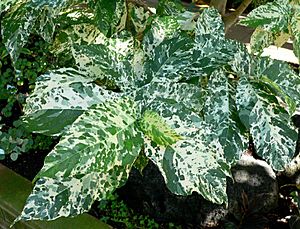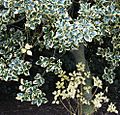Variegated leaf facts for kids
A variegated leaf is a plant leaf that shows different colors in patches or patterns. Instead of being just one solid color, like all green, these leaves have areas of white, cream, yellow, or even pink and red. This makes them look very interesting and unique. A common example is the money plant, which often has green and yellow leaves.
Contents
What Makes Leaves Variegated?
The main reason leaves are variegated is because some parts of the leaf do not have chlorophyll. Chlorophyll is the green pigment that helps plants make their own food using sunlight. When parts of a leaf lack chlorophyll, they cannot be green. This is why you see other colors like white or yellow in those areas.
Natural Variegation
Many plants naturally have variegated leaves. This can happen due to:
- Genetic changes: Sometimes, a plant's genes cause it to produce less chlorophyll in certain areas. This is like a natural birthmark for the leaf.
- Air pockets: Some plants have tiny air pockets under the surface of their leaves. These pockets can reflect light, making the leaf look silvery or white.
- Pigments: Other colors like red or purple can come from different pigments, not just the lack of chlorophyll. These pigments might be more visible when chlorophyll is missing.
Variegation from Viruses
Sometimes, a plant virus can cause variegation. These viruses can stop chlorophyll from forming in certain parts of the leaf. This type of variegation is not always good for the plant, as it can make the plant weaker.
How Are Variegated Leaves Used?
Variegated leaves are useful for a few reasons. They are very popular in horticulture, which is the art of growing plants. People love to grow them in gardens and homes because they look so pretty. They are also great for science experiments to show how plants make food.
Science Experiments with Variegated Leaves
Variegated leaves are perfect for showing that chlorophyll is needed for photosynthesis. Photosynthesis is the process where plants use sunlight to make glucose (sugar) for food. They store this sugar as starch.
Here is a simple experiment you can do:
- Step 1: Soften the leaves. Carefully place a variegated leaf in boiling water for about six minutes. This helps to soften the plant cells.
- Step 2: Remove the color. Take the leaf out of the boiling water and put it into ethanol (alcohol). The ethanol will remove the green chlorophyll from the leaf. The leaf will look pale.
- Step 3: Spread out the leaf. Once the leaf has lost its color, spread it out flat on a surface.
- Step 4: Test for starch. Soak the leaf in iodine solution.
- Step 5: Observe the results. The parts of the leaf that were green will turn blue or black. This color change shows that starch is present there. The parts that were not green (white or yellow) will stay the yellowish-brown color of the iodine. This proves that only the green parts, which had chlorophyll, made starch.
Images for kids
-
Variegation of fruits and wood in Ficus carica 'Panascè', a bicolor (yellow-green) common fig cultivar. This Italian cultivar is a chimera.
-
Variegation in holly leaves
-
Leaves of Red Clover (Trifolium pratense) have a typical v-shaped variegation.
-
Variegated foliage used in an English garden. Plants shown include Aralia elata 'Aureovariegata' and Carex ornithopoda 'Variegata'
-
The rare rainforest plant, Cryptocarya williwilliana, showing leaf venation and variegated leaves
See also
 In Spanish: Variegación para niños
In Spanish: Variegación para niños








